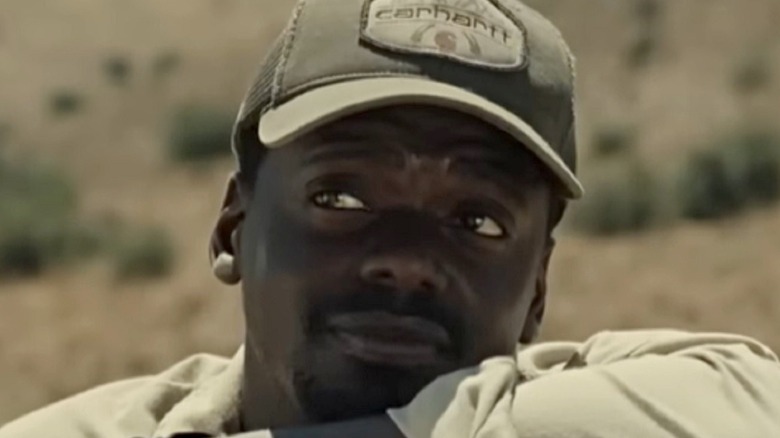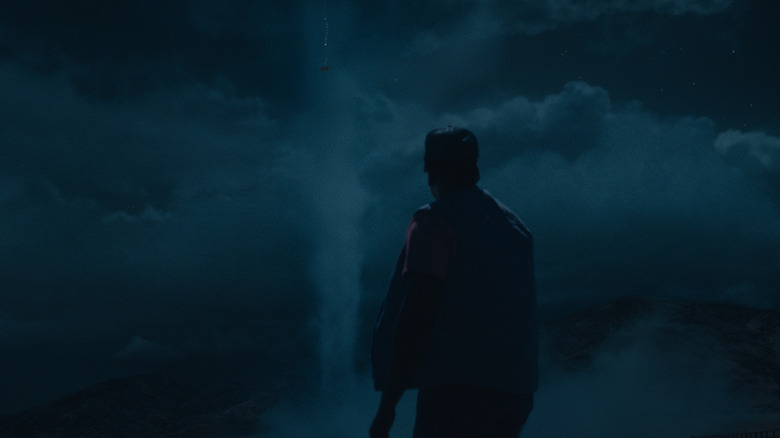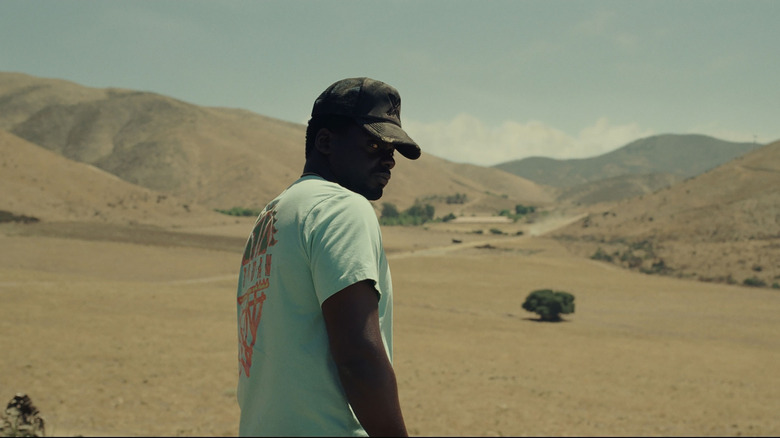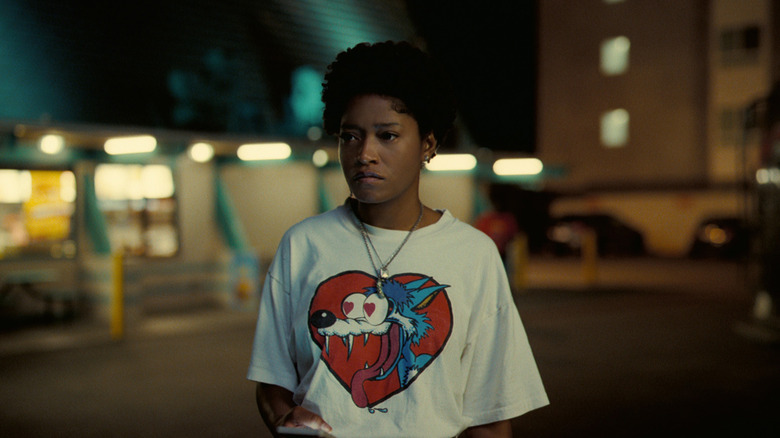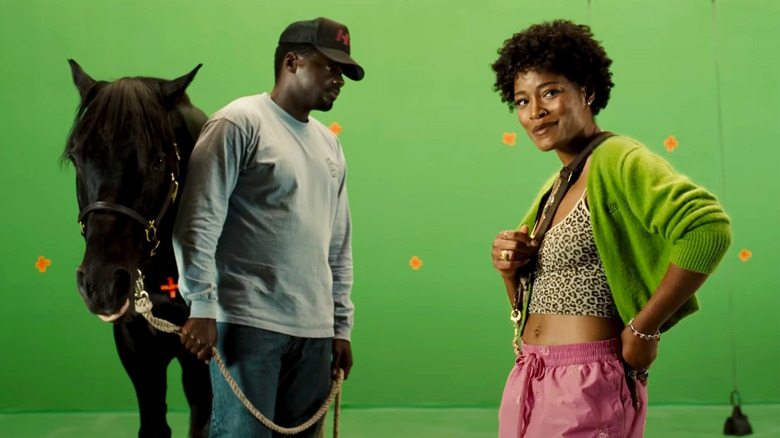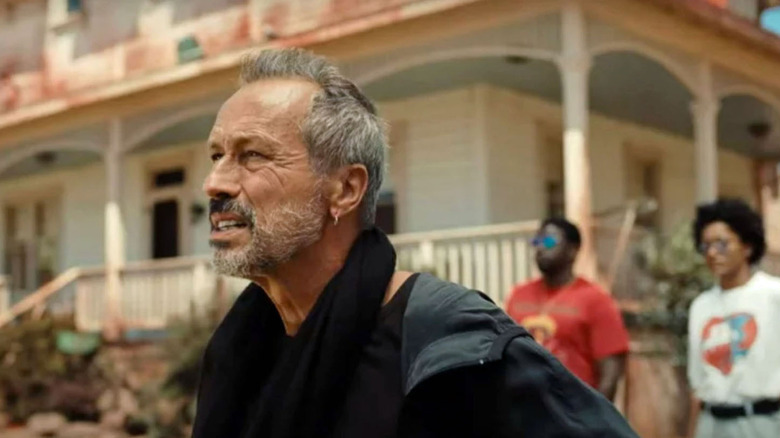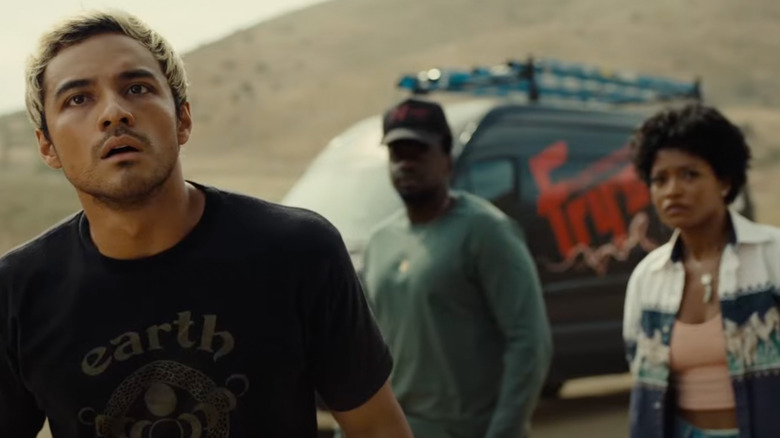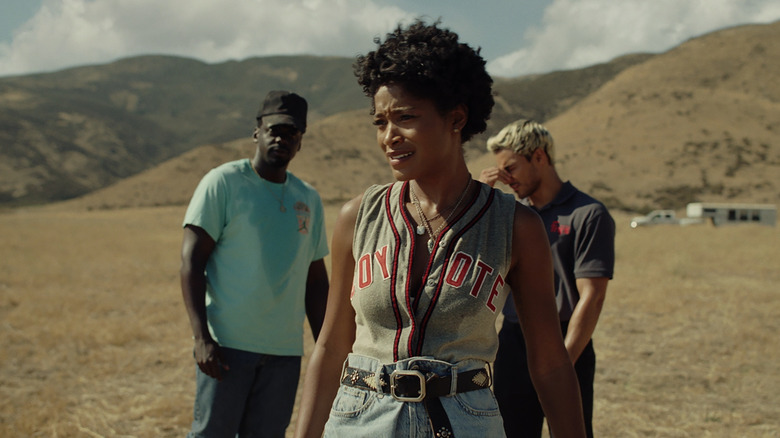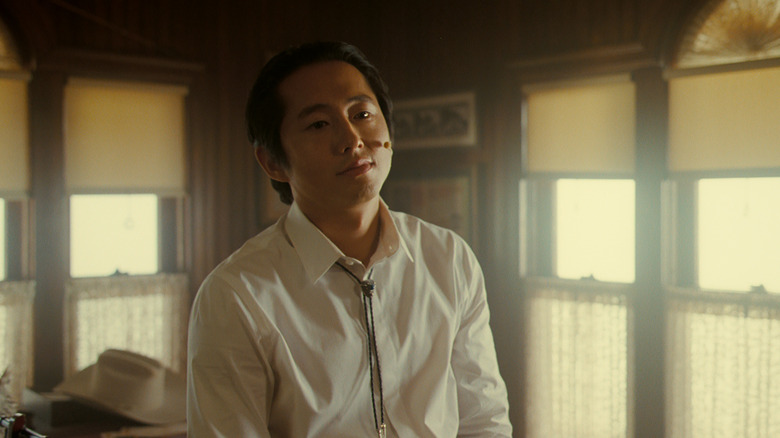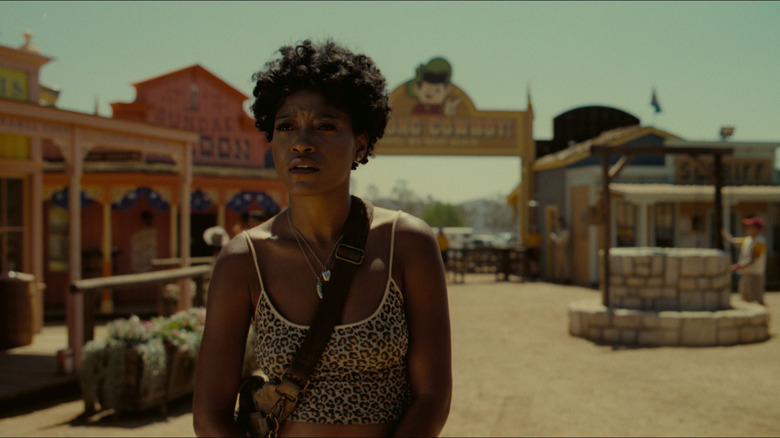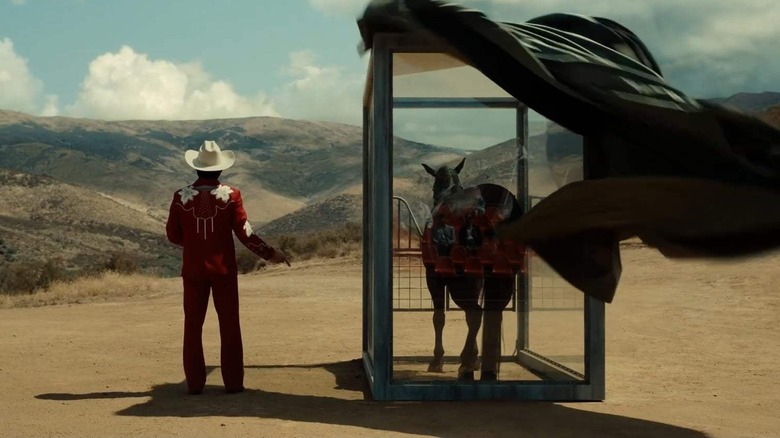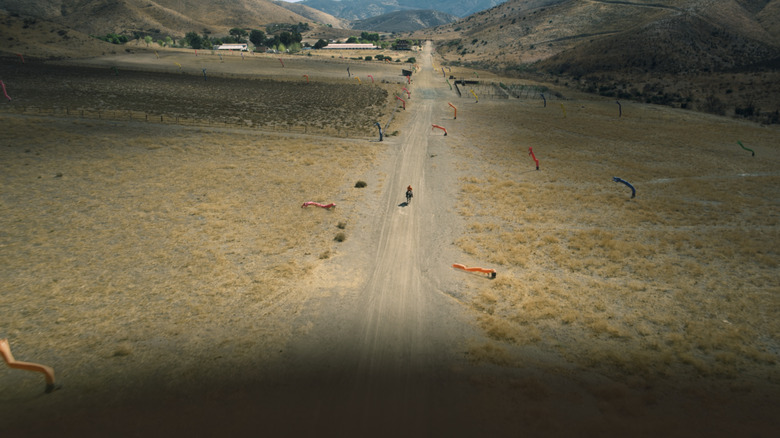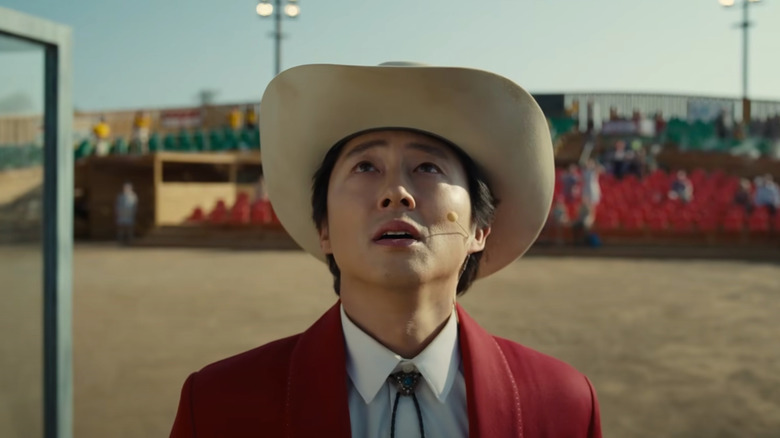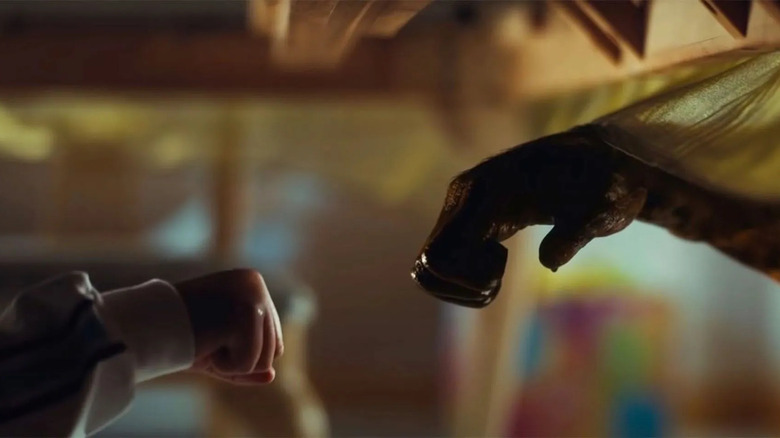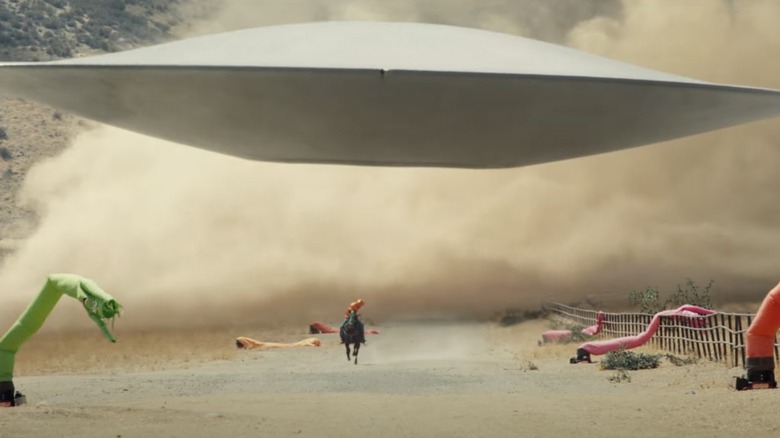The Ending Of Nope Explained
Jordan Peele's third film, one of the most-anticipated movies of 2022, gave audiences a lot of what they've come to expect from his work, and then some. With its story of two siblings trying to capture a UFO on film, "Nope" wowed audiences and critics alike with its primal thrills, dynamic visuals, engaging mix of humor and horror, and all-star cast led by the likes of Keke Palmer and Academy Award-winner Daniel Kaluuya. It also gave us Jordan Peele as we've never seen him before, delivering an ambitious mix of blockbuster scale and horror intimacy.
Then there's the ending, which is in many ways just as complex and layered as Peele's work on "Get Out" and "Us." From the ultimate answers to the film's UFO mystery to what happens to each major character, there's a lot to unpack, so let's not waste any more time. This is the ending of "Nope," explained.
Six months of chaos
"Nope" spans roughly six months, most of which we don't even see. It begins with the death of Otis Haywood Sr. (Keith David) when a falling nickel shoots into his brain. The authorities blame a freak accident for this, but six months later, his children OJ (Daniel Kaluuya) and Emerald (Keke Palmer) develop a different theory: A UFO is responsible, and their father's death is part of a larger pattern of violence.
What's especially significant about this six-month time period in the context of the larger story, of course, is that we simply don't know exactly how much chaos the UFO caused in those missing months between Otis Sr.'s death and his children discovering what's really going on. The film chooses to zoom in on a couple of key locations in this particular region of California, and we see what the UFO causes there, but the potential for more violence that we never got to see is strong. Things get even more interesting when you consider the film's reveal that the UFO is not a ship carrying aliens, but an alien being unto itself, a living thing that hides in clouds and preys on things living on Earth's surface. Whatever else happens in "Nope," one thing is clear: The real toll of the events of the film is likely much higher than what we see.
OJ and his father's shadow
OJ Haywood is living with trauma that he's reluctant to address. He witnesses the death of his father at the very beginning of the film and spends the rest of "Nope" trying to keep the family's horse ranch alive and kicking. For much of the film, he seems to be quietly failing in that effort, and the reminders of his father are never very far away. Otis Sr.'s memorabilia is all over the family ranch, and at one point we see that OJ has even kept the nickel that shot through his father like a bullet tacked to a wall, where he can always be reminded of just how strange his father's loss really is.
Over the course of the film, we see several flashbacks in which OJ recalls lessons from his father about life and horse training, lessons that he's then later able to apply to hunting the UFO and, ultimately, surviving it. By the end of the film, as the dust is literally settling, OJ emerges as a survivor of something that claimed his father's life, succeeding in his own way at something his father never got a chance to master. In some ways, OJ has just performed the ultimate feat of animal wrangling, growing beyond his father in the process. There's no doubt he'll continue to mourn Otis Sr., but whatever he chooses to do next, he'll move through it with a new sense of confidence.
Emerald and the horse she never tamed
Though she definitely claims to be very busy, with lots of projects going on and the Haywood ranch acting as a merge side hustled, Emerald Haywood is someone on the hunt for greatness. When the UFO begins to menace the ranch, she thinks she's maybe found her shot, a moment that can propel her to something bigger and a chance at achieving her dreams.
Of course, once she convinces OJ to go along with her plan, Emerald finds she's in way over her head, particularly when certain family resentments start to creep back in. For Emerald, who was always the outsider kid who didn't follow in her father's footsteps like OJ, this is a chance to make the family business about her for a change. When everything starts to go sideways, it challenges her view of what her family is, strengthens her bond with her brother, and most importantly, forces Emerald to realize her true strength in ways she never did before. When her brother names the UFO "Jean Jacket," after the horse her father took from her, Emerald takes on the responsibility of finally finishing the struggle, getting the shot, and even defeating the entity. By the end, she's come into her own.
The future of Haywood's Hollywood Horses
At the beginning of "Nope," Haywood's Hollywood Horses is struggling in the wake of Otis Sr.'s death, and struggling with the state of Hollywood in general. Horse wranglers are not as necessary and respected as they once were, and a single mishap on a commercial set leads OJ to lose a job and be replaced by a CGI animal at the last minute. It's an uphill battle for them to keep the ranch afloat, until they decide to focus much of their energy on capturing evidence of a UFO.
By the end, OJ and Emerald have succeeded in their quest to get some kind of footage of the entity, even if it's just a still photo taken with a novelty camera at Jupiter's claim, but they've also succeeded in banishing a dark force from their ranch. Do those two ingredients mean that they can rise above adversity and restore the ranch to its former glory? Is it better for the two of them to just move on at this point? How many horses survived the UFO encounters in the end? It's not clear what will happen to Haywood's Hollywood Horses, but it is clear that for OJ and Emerald, basically everything about their life has changed.
Antlers' legacy
When their own efforts to capture the UFO on film turn up short, OJ and Emerald turn to Antlers Holst (Michael Wincott), a famous cinematographer they met once on a commercial shoot, who is intrigued by the challenge of photographing such a strange object. Eventually lured out the ranch, Antlers even builds a completely manual camera to get around the UFO's ability to disrupt anything with a battery, making sure he's more likely than anyone to get the thing on film.
In the end, Antlers does manage to capture footage of the UFO, but he also ends up so driven by his own desire to do the impossible that he takes his portable camera and deliberately goes into the belly of the beast, sacrificing himself for the sake of his art.
The question now, of course, is whether or not any of that art survived. Both cameras were destroyed, in one way or another, by the UFO, and we saw at least one film canister unspooling as it rolled down the hill, but there's at least one film magazine unaccounted for, and we don't know what happened to Antlers' other film as he went up into the creature. It's possible his real legacy will be restored, salvaged footage of the UFO, his last great cinematic achievement.
Angel's survival
OJ and Emerald also get a hand from Angel (Brandon Perea), a curious and conspiracy-loving employee at an electronics store who comes out to set up their surveillance equipment for them and then, without permission, decides to monitor their progress from a distance. At first, OJ and Emerald want to keep Angel at a distance, but over time he becomes a key part of the operation.
By the end of the film, Angel is caught up in the path of the UFO, to the point that he seems convinced he's about to face his own death. To counteract that, he wraps himself partially in barbed wire, hoping that the sharp fencing will damage the UFO's digestive tract and help him to get free. He's right. The creature is indeed wounded, and Angel falls down into the desert, still alive even if he is a little battered.
The film doesn't show us what happens to Angel next, but there's a very good chance that he'll spend the rest of his life telling anyone who will listen about what he experienced, regardless of whether or not he's got proof. The film's greatest UFO evangelist has finally seen the truth, and there's no way he's letting that go.
Other cameras
In the film's climax, Emerald rides to the closed Jupiter's Claim theme park, doing her best to lure the UFO along with her, in the hope that she can use the camera at the bottom of the wishing well to capture one last image. Her plan pays off, as she uses a giant Jupe balloon to lure the UFO into the frame, takes the picture, then watches as the balloon pops and destroys the UFO creature in the process.
As she declares victory, Emerald takes a moment to rest on the ground in the middle of the theme park, only to realize she's not alone. News crews who were there to cover the mass disappearances at the park are just outside the gates, and if they didn't see the whole thing unfolding, then they at least saw part of it, and they may have seen it from outside the sphere of electrical interference caused by the creature. So, did any of them get footage? Are they going to steal Emerald's thunder? Are they going to believe her when she tells her story? One thing's for sure: They're not about to just abandon the story as it's getting interesting.
Jupe's discovery
After spending much of the film building up his new show at the theme park, Jupe (Steven Yeun) finally reveals what he's been working on in one of the film's most memorable sequences. The new "Star Lasso Experience" at Jupiter's Claim is actually the UFO itself, which Jupe has been watching for six months, learning its behaviors so he can lure it out to become a public spectacle. That plan backfires spectacularly because Jupe misunderstands how the UFO huts, and he and his entire audience are killed when the creature descends, sucks them all into the sky, and devours them, spitting their blood back out onto the Haywood family home.
While he doesn't get everything right in attempting to harness the power of the UFO, it's clear that Jupe has been watching it for some time and planning a show around it. So, who did he tell, other than his wife and perhaps his staff, who are also all dead now? Is anyone else out there very aware of what Jupe was doing, and willing to talk about it? Does the UFO have a wider sphere of influence than the film might lead us to believe? The answer isn't clear, but the investigation won't stop with Jupe's death.
The Oprah shot
Throughout the film, Emerald and OJ talk regularly about getting "the Oprah shot," an image of the UFO so impressive that even Oprah Winfrey will be wrapped up in its spectacle and power and want to feature them on television. All of their early attempts, from phones to surveillance cameras, fail in this effort, and even Antlers' attempts to get the thing on film with a mechanical camera may have come up short when his film was put through the wringer. Still, with help from the wishing well camera at Jupiter's Claim, Emerald makes the Oprah shot happen, pulling off a beautiful shot of the creature just as it swallows the Jupe balloon she sent up into the sky.
That Emerald managed to get an impressive shot to share with the world is not in question. What's perhaps more important at that moment is what it cost her to get it. She's lost friends, horses, much of the family farm, and nearly her brother and her own life to get the Oprah shot, and now we're left wondering: Was it worth it? It's a lasting question that "Nope" asks about every major spectacle visited throughout the film, from TV shows to carnival attractions.
Government response
Nearly every major film about UFOs suggests at least the possibility of government response to the crisis – the idea that the higher-ups running the country are, if not already aware of what's happening, then about to find out. Government presence is essentially absent in "Nope," though we do hear of authorities dismissing Otis Sr.'s death as a plane accident and chalking up the Jupiter's Claim disappearances to "flash flooding." It's enough to make you wonder if maybe the government is already aware, and at least trying to cover it up.
Whether the government already knows what's been going on or not, it's clear that someone will clue them in somehow by the time the story of "Nope" is over. Whether we're talking about the images the Haywoods capture, Angel telling his stories, or the TV news crew spreading the word and sparking conspiracy theories, it's going to be on someone's radar. Will the government initiate a cover-up? Will they allow the Haywoods to go public? We don't know, but they're probably not just going to stand by.
OJ's survival
In the final moments of "Nope," Emerald stands up in the middle of Jupiter's Claim and looks out into the distance. She catches her breath for a moment, closes her eyes, and when she opens them again, she smiles. The camera shows us that OJ has ridden up to meet here, and he and Lucky the horse are standing just outside the gates that lead to the park's arena. Then the film ends.
"Nope" is a fairly straightforward, easy-to-follow film, but for the sake of covering all the bases, it's worth at least entertaining the possibility that OJ has somehow died and that Emerald is just seeing her brother through pure hope. OJ doesn't make a move to interact with her in this scene, nor is he even moving his horse, and the sign just above him says "Out Yonder," which could be a nod in the direction of the great beyond. Much of the main arc of the film is about Emerald growing up and learning to handle things on her own without her father or her brother, and in killing the UFO, she achieves that. Maybe this is the film's way of telling us she's now moving beyond her family and into something. Or maybe OJ's just standing there, waiting to give her a ride back to the ranch. Given the way the finale is staged, it's probably up to audiences to make up their own minds.
The viewers
During his opening remarks at the "Star Lasso Experience," Jupe describes the UFO and explains that he's taken to calling the beings he believes are inside "The Viewers." It's a brief mention, and the only name the UFO really gets over the course of the film, but it's also a clue into the larger symbolism at work in the film.
OJ and Emerald work in the film industry. Jupe is a former child star who's become a theme park promoter. In other words, their entire lives are built in some way around getting "viewers" to pay attention to them, whether it's on a stage or in movies, or just in a commercial. Attention is a key part of their economy, and now they've attracted the attention of a "Viewer" in the UFO that is a seemingly relentless, unreasoning consumer of content. It doesn't care what you want or who you are. If you're looking at it, it's looking back at you, ready to eat you alive. By calling the UFO a "Viewer," Peele has made a fascinating point about the nature of spectacle, our human sense of curiosity, and what we're doing when we treat other people as objects to be ogled. It's a great metaphor in the middle of a thoroughly entertaining film.
The importance of Gordy
The opening shot of "Nope" is a seemingly incongruous shot of a bloodied chimpanzee on a TV set, sitting next to what seems to be a dead human body. Later in the film, we learn that this is Gordy, the chimp star of Jupe's second major role in a sitcom called "Gordy's House." During a shoot one day, a popping balloon set Gordy off, and he attacked his human co-stars, seemingly killing two of them, before turning his attention to Jupe. Jupe, who was hiding under a table, is terrified until he realizes the chimp actually just wants to do their trademark fist bump, a sign of the bond they share. Before he can re-establish that bond, though, Jupe watches as Gordy is gunned down by first responders.
Though he tries to play it off in adulthood, Gordy's death plainly had a major impact on Jupe, who takes some of that unresolved emotion and brings it to bear on the UFO. If he could connect with a homicidal chimp, he thinks, he can connect with a UFO in the sky. He's wrong, of course, in keeping with Otis Sr.'s lesson that some animals just don't want to be tamed. It's a key part of Jupe's character that he's convinced he can do it, and an enlightening subplot in the overall saga of the UFO.
UFOs and the wider world
Though it's definitely got an epic feel, much of the action of "Nope" is contained to a single valley in California, as a single family tries to contend with the realization that they've encountered a UFO. Over the course of the film, OJ and Emerald learn a lot of things about this strange visitor, from its feeding habits to its hiding places. What they don't learn, of course, is how the UFO came to settle near their home in the first place, or whether or not more such creatures exist around the world.
Is "Nope" giving us the secret history of all flying saucers, revealing that alien visits are actually the occasional drop-in from a cosmic predator hungry for living things? Is this the explanation for all of those weird saucer-shaped objects and mysterious disappearances throughout human history? Or is it an isolated incident, or the story of a new species of predator that's figured out it can hunt by pretending to be a flying saucer? Chances are, there's no "Nope Part 2" on the horizon, but if there is, these are exactly the kinds of questions it could answer.
